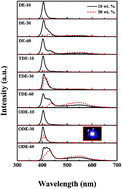The application of Zn0.8Cd0.2S nanocrystals in white light emitting diodes devices†
Abstract
In this study, colloidal ternary semiconductor Zn0.8Cd0.2S (ZnCdS) nanocrystals (NCs) with wide emission and high quantum yields (QYs) have been prepared and used as nanophosphors in white light emitting diodes (WLEDs). The optical properties of ZnCdS NCs-based WLEDs including Commission Internationale de l'Eclairage (CIE) chromaticity coordinates, correlated color temperature (CCT), color rendering index (CRI) and luminous efficiency can be adjusted by the various ZnCdS NCs, using different carbon chain lengths of alkenes as surface ligands, reaction time, NCs contents and encapsulation methods. The optimal conditions of CIE, CRI, CCT and luminous efficiency, and decay during stability test for ZnCdS NCs-based WLEDs are (0.32, 0.30), 82, 6811 K, 4.26 lm W−1, and 0.036 lm W−1 h−1, respectively by the UV chip with only one type of ZnCdS NCs layer. The results have exhibited the potential application of ZnCdS NCs as nanophosphors in WLEDs.


 Please wait while we load your content...
Please wait while we load your content...